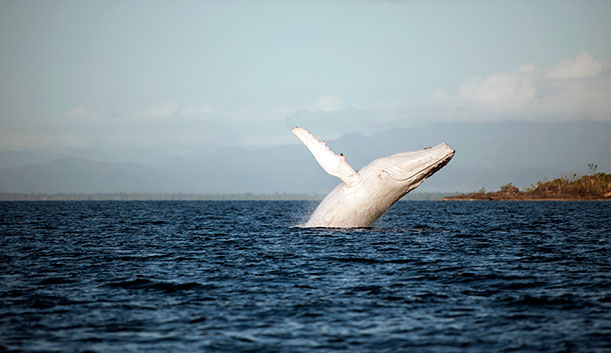Call Me Migaloo: The Story Behind Real-Life White Whales
White whales, such as the recently spotted humpback nicknamed Migaloo, are rare and elusive creatures. How many are there and why are they white?
/https://tf-cmsv2-smithsonianmag-media.s3.amazonaws.com/filer/White-whale-631.jpg)
“Call me Migaloo,” would start the memoir of the most famous white humpback whale out there. He’s not quite from the pages of Moby Dick—Herman Melville’s white whale was a sperm whale and not entirely white—but Migaloo still makes quite a splash when he lifts his head or tail above the waves.
First spotted in 1991, he’s been seen more than 50 times since, including a few times around the Great Barrier Reef this summer. But the probable-but-unconfirmed spotting by Jenny Dean, a Queensland, Australia native, takes the cake. A few weeks ago, she captured Migaloo breaching in a spectacular photo, showcasing the whale’s bright whiteness that nearly looks photoshopped.
But what’s the deal with Migaloo and white whales? Let us ocean enthusiasts from the Smithsonian Ocean Portal answer your questions.
What do we know about Migaloo?
In the past 22 years since whale watchers first spotted the exceedingly social Migaloo—so-called after the Aboriginal word for “white fella”—scientists have been able to learn a bit about him. They think he was around 3-5 years old when first spotted, which makes him 25-27 now. Barring an unfortunate accident, he may have another 50 years ahead of him, although scientists don’t know for sure how long humpback whales live because they don’t have teeth—like tree rings, analyzing concentric layers in teeth is a common way to measure age in mammals.
They know he’s a male from his song. While both male and female humpback whales produce sound, only males sing the melodic humpback songs that long ago captured our imaginations. In 1998, researchers first recorded Migaloo singing—and his knack for melody gave it away.
His maleness was further confirmed by DNA after researchers from Lismore, Australia’s Southern Cross University, collected skin samples from Migaloo in 2004.
Are white humpbacks rare?
As far as we know, exceedingly so. Besides Migaloo, there are three other known white humpbacks. Willow lives up in the Arctic and was spotted along the coast of Norway in 2012. Meanwhile, Bahloo lurks in Migaloo’s territory in the Great Barrier reef, first seen in 2008. But these two are not as gregarious as Migaloo, rarely showing their faces.
The other known white humpback is a calf first seen swimming around the Great Barrier Reef in 2011. Unofficially named “Migaloo, Jr.,” the calf is not known to be the child of Migaloo—in fact, the two whales may not even be related. If a DNA sample from the calf is obtained someday, they could compare it with Migaloo’s genetic profile to find out.
There probably are more white whales out there, however. These are just the ones that have surfaced near people with cameras. Two years ago, an unknown white whale washed up on a beach, and if you dig around on the web, you can find even more.

Photo by Jenny Dean
How do we know these aren’t the same white whale?
In the case of Migaloo, Jr., it’s pretty obvious: he’s much smaller than the Migaloo Australians are so familiar with.
Bahloo and Migaloo hang out in the same area and, because Bahloo rarely shows its face, you could argue that the two are actually the same whale. But photos taken in 2010 showed a few black spots on Bahloo’s head and tail, differentiating it from Migaloo. Willow also has black patterns on the underside of its tail, making Migaloo the only documented all-white whale. These patterns and markings are distinct for each whale, white or otherwise, allowing researchers to track the creatures through detailed observations.
Why is he white anyway?
Many articles describe Migaloo and the other white whales as albino. But making that diagnosis is easier said than done.
Albinism is a genetic disorder in which the protein tyrosinase, which helps to produce the pigment melanin, is completely absent or damaged by a variety of possible mutations. Fully albino animals and people have no melanin whatsoever; they are white or pink from head to toe, including their eyes.
Willow and Bahloo are not albino: they have black spots or patches on their bodies. It’s more likely that they have leucism, a condition where all pigment types are lost in patches of cells.
Even though Migaloo is all white, scientists are skeptical that he is albino because he doesn’t have red or pink eyes—like other humpbacks, he has brown eyes. Instead, he’s considered the more conservative “hypo-pigmented,” describing a generic loss of skin color. It’s also possible that Migaloo is leucistic.
The Southern Cross University researchers could analyze his DNA for different genetic variants associated with pigment disorders to pinpoint the exact form. But there are many variants and, as Megan Anderson, who originally tested Migaloo’s DNA, said in a press release, “It’s going to be a long and complex process to test for albinism in this humpback whale as it has not ever been done before.”
And what about the calf? There isn’t enough known about it to be sure.
Yes! These skin disorders are not exclusive to humpbacks. There have been several other wild spottings of white whales recently.
A white right whale calf (incorrectly described as albino) was filmed last year off the coast of Chile by a group of surfers. Last April, researchers spotted a white killer whale off the coast of Alaska, and they named it “Iceberg.” And a truly albino pink dolphin has been seen around Florida and the Gulf of Mexico repeatedly over the years.
In fact, whales aren’t the only creatures that can lack pigment. A plethora of other all-white examples—such as koalas, penguins, and gorillas—can be found throughout the animal kingdom.
 Learn more about whales and other marine mammals on the Smithsonian’s Ocean Portal.
Learn more about whales and other marine mammals on the Smithsonian’s Ocean Portal.

